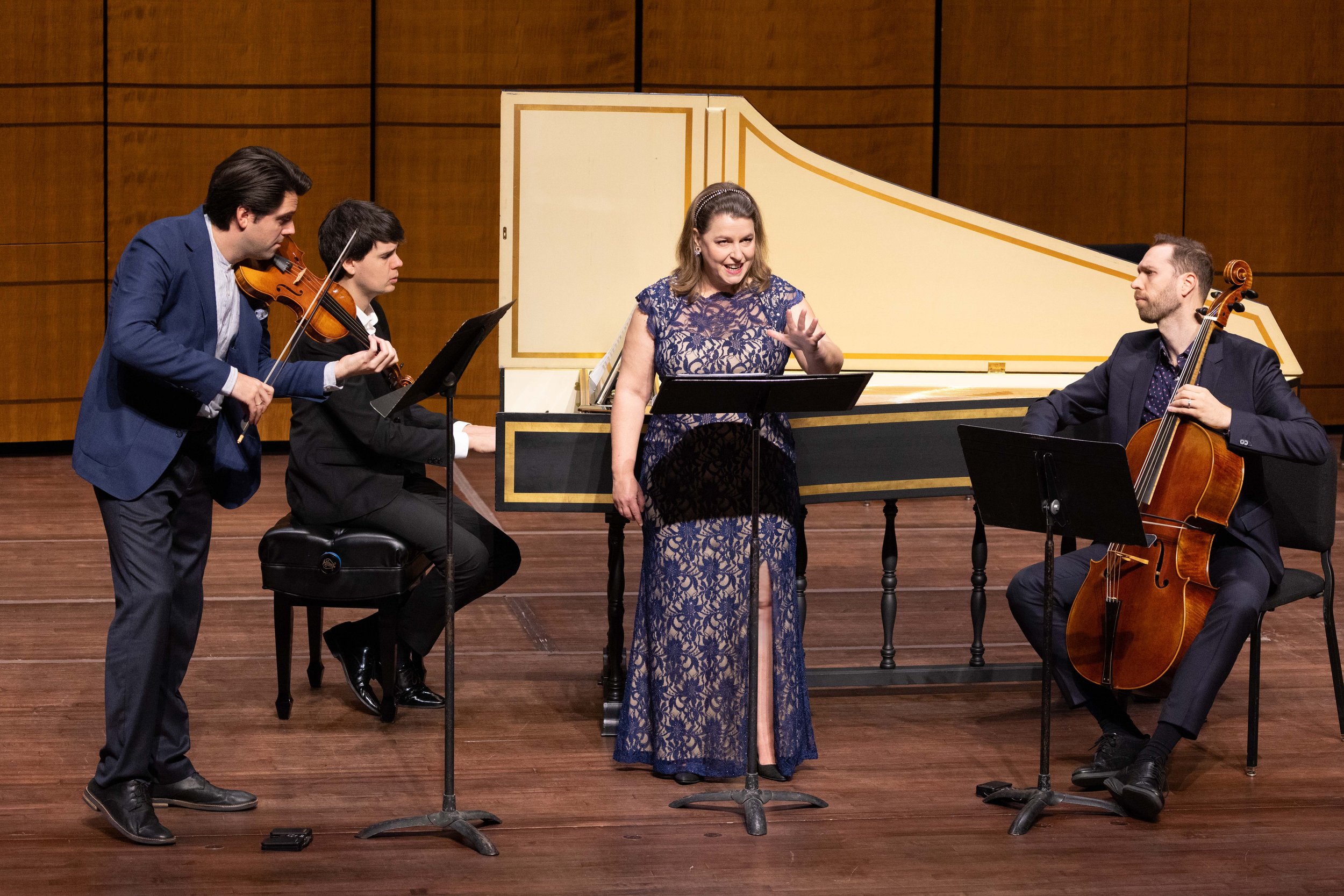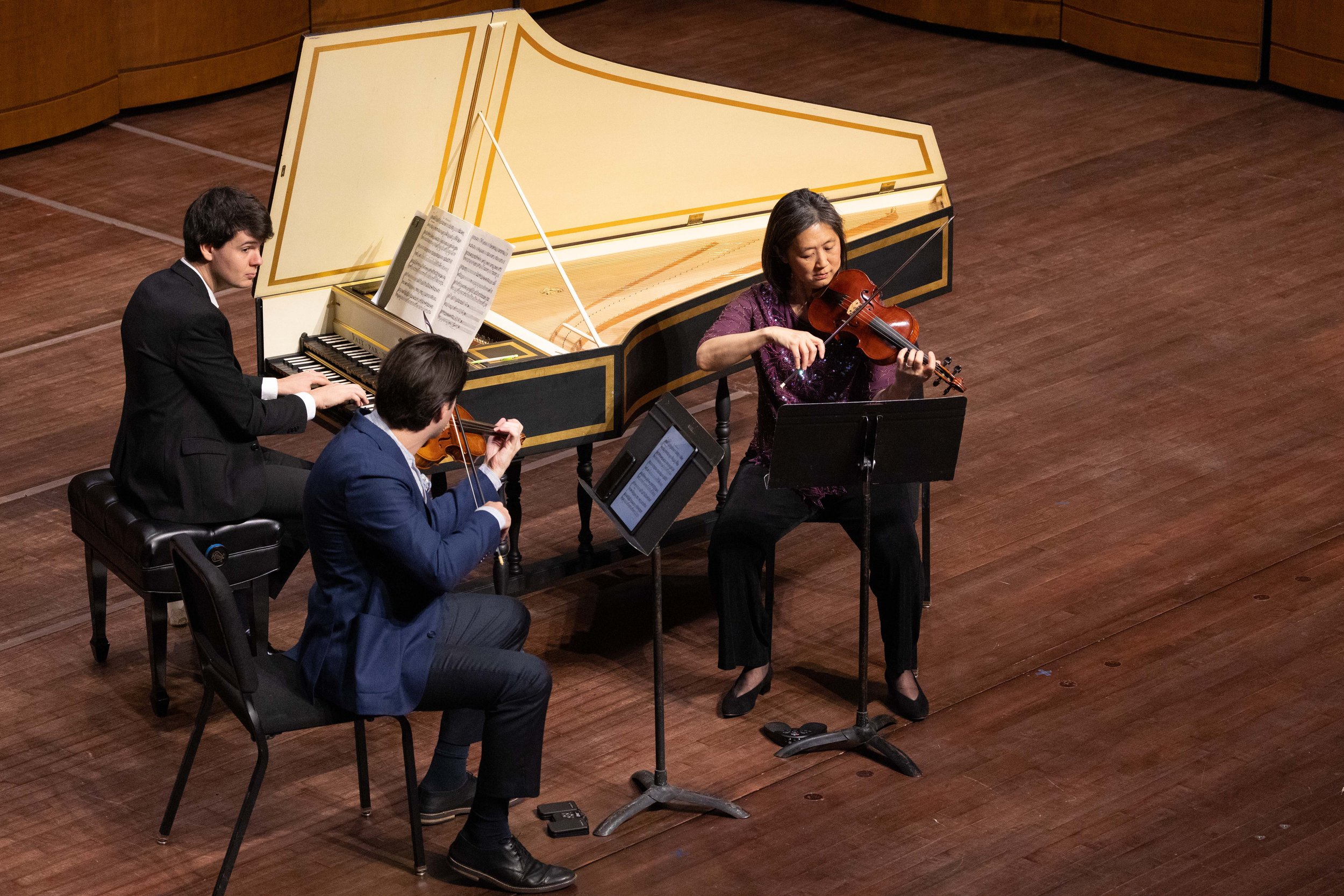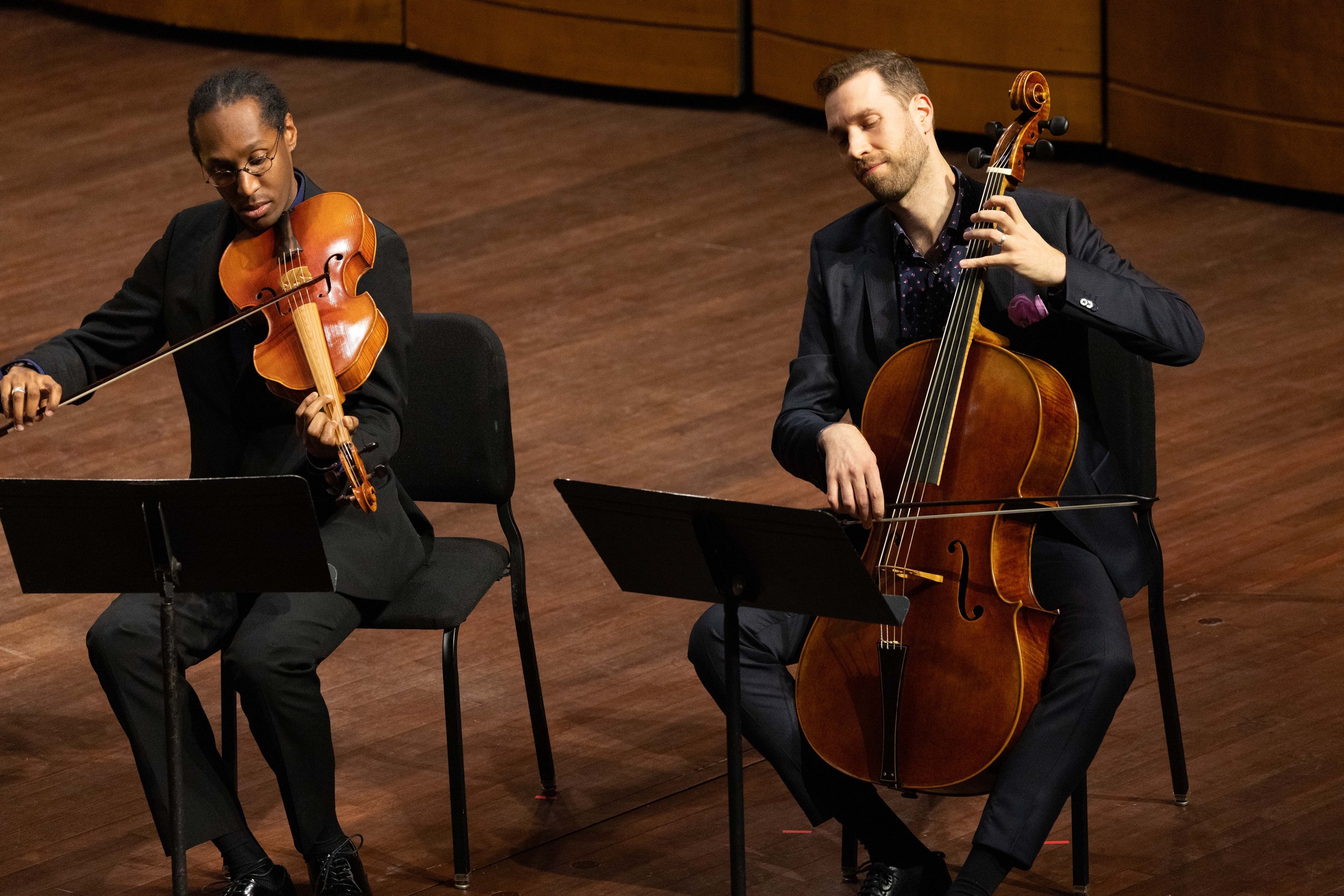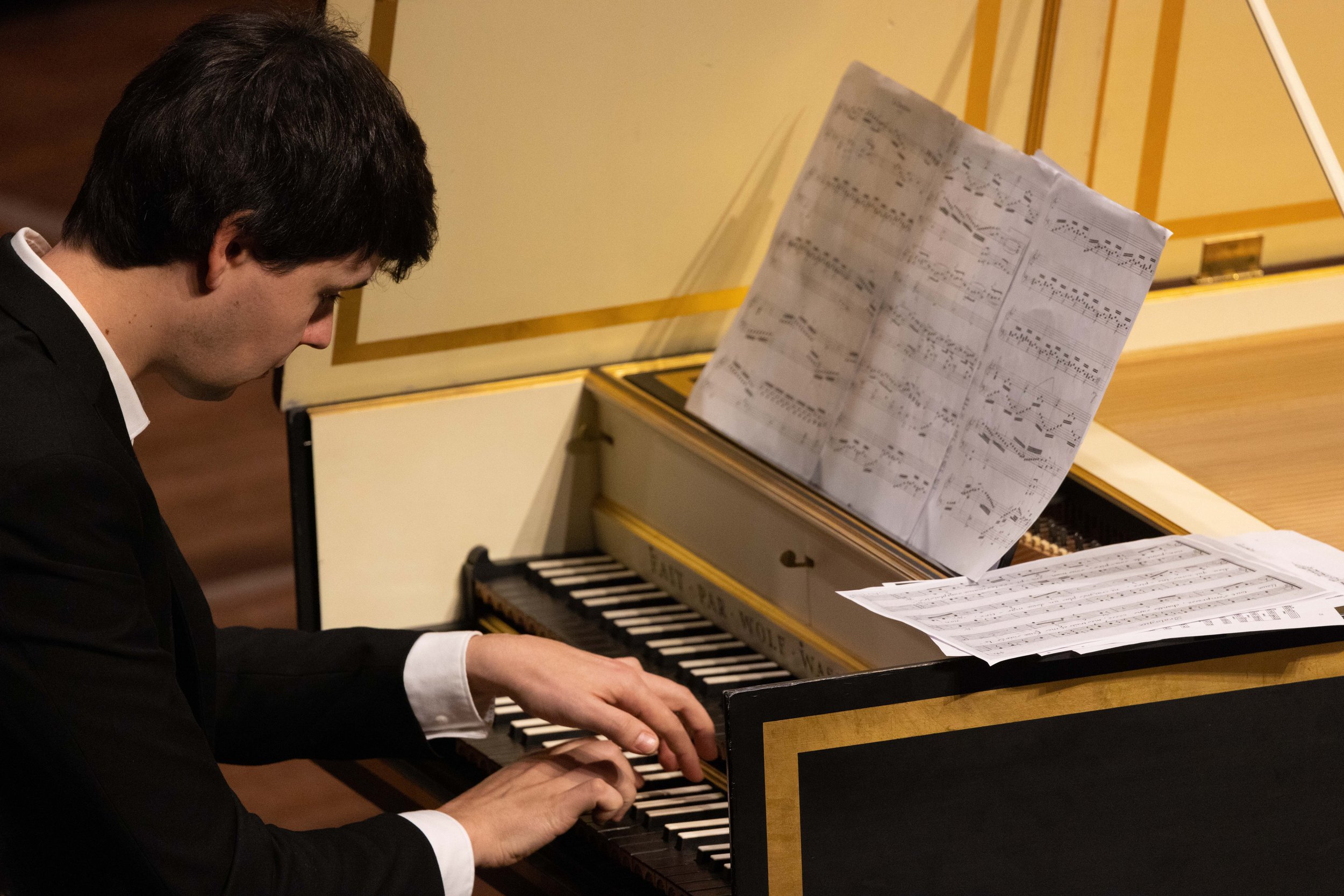Opera Lafayette’s first performance of the 2022-2023 season was like visiting the Smithsonian’s precious stones exhibit, each piece dazzled. On Friday evening in the Kennedy Center’s Terrace Theater, OL gave their fans a French salon experience performing selections that not one, but two mid-eighteenth-century women salonniéres of influence might have arranged, one who preferred an all-French composer program and one with a love of composers across Europe. The program for “In the Salons of Versailles”, designed by violinist Jacob Ashworth, featured a renown French soprano and an ensemble of highly regarded early music specialists:
l to r: Jacob Ashworth, June Huang, Justin Jonathan Taylor, Emmanuelle de Negri, Isaiah Chapman, and Serafim Smigelskiy. Photo by Sierra Prasada; courtesy of Opera Lafayette.
Artists:
Jacob Ashworth…musical direction & violin
Emmanuelle de Negri…soprano
Justin Jonathan Taylor…harpsichord
June Huang…violin
Isaiah Chapman…violin
Serafim Smigelskiy…cello
Last year, OL began the first of three seasons dedicated to eras associated with French women who exerted an influence on French music and history of the 18th century, with eras of Marie Antoinette, Madame de Pompadour, and Madame Maintenon (see my overview of OL’s 2022-2023 season devoted to the “Era of Madame de Pompadour” at this link). Approximately half of the Salons’ program were selections that Madame de Pompadour might have made and the other half likely choices of Dauphine Marie-Josèphe de Saxe, also an influential member of the court at Versailles at that time.
Jeanne Antoinette Poisson, Marquise de Pompadour was chief mistress of King Louis XV from 1745 to 1751, and friend and confidante beyond that. Though a member of the bourgeoise and not nobility, she came to be useful to the king in some areas of decision making and was awarded her title. She was an astute politician who used support for the arts to overcome prejudice against her for being a commoner and to increase her influence. Her love of music was genuine; she was a talented soprano and harpsichordist. Her co-salonniére for this program, Marie-Josèphe de Saxe, was born into nobility and became Dauphine through an arranged marriage to a son of Louis XV. She also was a talented harpsichordist. Whereas M. de Pompadour strictly favored French music, the Dauphine, born in Dresden, pushed the court to be more cosmopolitan in its appreciation and support for music. Both seemed to have agreed on Rameau’s eminence (I’ll make that three). The distinctions in their preferences was reflected in a controversy of the day called the Guerre des Bouffons, a hotly contested argument over whether French music or Italian music was superior.
The historical background for this production was provided by Opera Lafayette in educational offerings prior to the concert, in a pre-opera talk, and in the online program. The concert itself was straightforward with the performers entering and leaving the stage without introductions or comments. English subtitles were provided on a screen for the vocals.
left photo: Jacob Asworth, Justin, Jonathan Taylor, and Serafim Smigelskiy. right photo: Justin Jonathan Taylor, Jacob Ashworth and June Huang. Photos by Sierra Prasada; courtesy of Opera Lafayette.
“In the Salons of Versailles” Program:
Pièces de Clavecin avec voix ou violon, Op. 5 – Jean-Joseph Cassanéa de Mondonville
III. Benefac Domine (performers: de Negri, Taylor, Ashworth)
VII. Quare trusts es, anima mea (de Negri, Taylor)
“Fureur, amour, secondés mon impatience” from Scanderberg – François Rebel and François Francœur (de Negri, Taylor, Smigelskiy)
Pièces de clavecin en concert: Cinquème concert – Jean-Philippe Rameau
I. La Forqueray (Taylor, Ashworth, Huang)
II. La Cupis (Taylor, Ashworth, Huang)
III. La Marais (Taylor, Ashworth, Huang)
Sonata for Harpsichord and Violin, K.6 – Wolfgang Amadeus Mozart (Taylor, Ashworth)
“Lascia i fior”: Cantata for Soprano and Continuo – Johann Adolph Hasse (de Negri, Taylor, Smigelskiy)
Sonata for 2 Violins in E Major, Op. No. 12, No. 2 – Jean-Marie Leclair
III. Minuet, non troppo allegro (Ashworth, Huang)
IV. Allegro (Ashworth, Huang)
Concerto for Violin in B-flat major – Giovanni Battista Pergolesi (Ashworth, Huang, Chapman, Smigelskiy, Taylor)
“Loin de nos coeurs les tristes plaints” from Scanderberg – François Rebel and François Francœur (de Negri, Ashworth, Smigelskiy, Taylor)
La Dauphine for Solo Harpsichord - Jean-Philippe Rameau (Taylor)
“Mentre dormi Amor fomenti” from L’Olimpiade – Giovanni Battista Pergolesi (All)
“Sur nos coeurs épuise tes armes” from Zoroastre - Jean-Philippe Rameau (All)
left photo: Isaiah Chapman and Serafim Smigelskiy. right photo: Justin Jonathan Taylor. Photos by Sierra Prasada; courtesy of Opera Lafayette.
Opera Lafayette Founder and Artistic Director Ryan Brown has forgone his usual involvement as conductor and violinist this season to remain largely behind the scenes, allowing other creative staff and performers the opportunity to develop their skills in this area. The selections for “In the Salons of Versailles” were well chosen by Mr. Ashworth; I’m sure Madame de Pompadour and the Dauphine would have approved. Perhaps because of my life long exposure to cosmopolitan, cross cultural, and multi-generational music, I had trouble seeing what the Guerre Bouffons fuss was all about. The program seemed highly cohesive to me, combining both women’s preferences.
The selection of performers was also outstanding. The musicians all performed with impressive artistry. Opera Lafayette takes pride in the authenticity of its performances using period instruments. I had the feeling it was a privilege to hear this group perform. Special recognition should go to soprano Emmanuelle de Negri. She seemed supremely confident, at home, and in control of the moment. The lush, beautiful sound of her voice and her extraordinary artistry singing with both emotion and technical skill seemed the perfect fit for this program.
Overall, Opera Lafayette’s “Salons of Versailles” was a pristine, elegant, and beautiful program that I thoroughly enjoyed.
The Fan Experience: All of Opera Lafayette’s productions for 2022-2023 will be performed in both Washington, DC (Terrace Theater of the Kennedy Center) and New York City (El Museo del Barrio). In DC, they will be spread over the entire season and in NYC performed as a festival.
-Washington, DC:
In the Salons of Versailles – December 2
Pergolesi! - February 2
Opéra-ballet - Rameau’s Io and de La Garde’s Léandre et Héro - May 2,3
-New York City:
Opéra-ballet: Rameau’s Io and de La Garde’s Léandre et Héro - May 9
In the Salons of Versailles - May 10
Pergolesi! - May 11
Christine Adams, co-author of The Creation of the French Royal Mistress: From Agnès Sorel to Madame Du Barry, gave an excellent pre-opera talk on Madame de Pompadour. She illuminated the talents and achievements of a woman who rose from the bourgeoise to have great political influence in 18th century France.
A digression for the interested: I’d like to pose the question of how might a 21st century audience be expected to respond to performances composed and performed with 18th century audiences in mind. The beauty would come across for both audiences and there would be pleasure for both. However, the 18th century auditory environment was very different from today’s. The only music heard in the 18th century was live and the constant noise we hear today (cars, planes, ambulances, etc.) was largely absent then. It’s likely few suffered from sensory overload in those times; any piece of music heard by them must have seemed more exciting and special when choices were so much more limited. OL reviewed historical aspects of the salon for attendees separate from the performance for those who took advantage of them (a minority), but 18th century listeners likely had some familiarity with the composers and performers already as well as the language. They would have had added expectations creating excited anticipation. The Guerre des Bouffons of that period pitting French versus Italian music would have perhaps made them more excited to attend; something akin to football fans today? No question that all of last night’s performances were jewels, but they were jewels displayed separate from their settings for most of today’s audience. No doubt the painting is what is important, but the framing can enhance or distract from its appeal and the likelihood it will convey its message. Somehow, I have the feeling it lacked the excitement it could have generated presented differently.
I remember a few years back that Wolf Trap Opera staged the opera L’Opera Seria by including cast members in the audience who behaved like audiences of that day might have behaved; it was great fun and gave me a better appreciation of opera in that day. In 2020, Opera Lafayette converted a French opéra comique to a Colorado comic opera in cowboy english. It might be interesting to see a French salon performed that way. “In the Salons of Versailles” might have knocked the socks off an 18th century audience. Though flush with enjoyment and appreciation, my socks stayed on; I have to admit my wife said her socks did come off. I guess that I am just jealous that I can’t hear it the way that someone in the 18th century would have.





